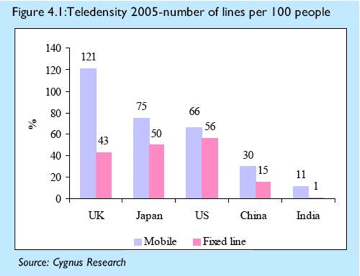Information Infrastructure: Stage 4

Chengdu, China. Image Source: Flickr
According to the CIA World Factbook, China has the most Internet users in the world; 389 million users were connected in 2009. China's Internet population is projected to reach 718 million users by 2013. 15.2 million Internet hosts existed within China in 2010, which ranked China as number six in the world. The United States was number one. China is the number one country for landline telephones; there were 313.6 million in use in 2009.
Although China is ranked high in rank of main line and mobile cellular telephones, it is continuously working to improve its telecommunications. In 2008, China restructured its telecommunications industry. Six telecom providers were consolidated into three. The three services, China Telecom, China Mobile, and China Unicom, each provide fixed-line and mobile services.
China Telecom
China Telecom is the largest of the three, according to their website; the company is the world's largest landline and broadband provider. In addition, China Telecom provides mobile communication services and mobile 3G Internet services. By 2009, the company had 194 million landline telephone subscribers, and 61.75 million broadband subscribers.
China Mobile
China Mobile is the leading mobile services provider in China, according to their website. The company has 522.2 million customers and 70.6% market share. The company's 3G service, launched in 2009, has 3.4 million customers.
China Unicom
According to the China Unicom website, the company has a large GSM and CDMA cellular business. The company covers 31 provinces, municipalities and autonomous regions in China. Additionally, the company provides landline voice, broadband and other Internet-related services. Business and data communications services can also be purchased from China Unicom, and it is the number two mobile operator.

The information Infrastructure in China is in Stage 4 because of the high teledensity and is the highest in developing nations. By 2005, its Mobile and Fixed Line teledensity has reached 45%. It also had widespread access to telecommunications and network services.
Internet Availability: Stage 4
As of June 2010, the number of broadband users as dramatically increased to 363.8 million users. Internet World Stats reports that 31.6% of people in China use the Internet. Chinese users spend an average of 19.8 hours per week on the Internet.
75.9% of Chinese Internet users, about 104 million people, use broadband connections that including DSL, Cable Modem and leased line. The broadband penetration is at 98.1%, but the underlying architecture may not be able to handle that much traffic, leading to problems with insufficient bandwidth.
Internet usage in China will continue to drastically rise in the coming years as more people get network access. Public Internet access is available for people in the form of cybercafes, which are very popular with the younger generation.
Businesses are able to get a corporate lease line or DSL broadband from a wide array of Chinese ISPs, and rate are low. Sometimes, newly built office have Internet access included with their rental.
The Internet Availability is in Stage 4 because it has high bandwidth solutions such as DSL and cable modem access. There are also adequate opportunities for public Internet access in the form of cybercafes, if home access is not possible.
Internet Availability: Stage 4
As of June 2010, the number of broadband users as dramatically increased to 363.8 million users. Internet World Stats reports that 31.6% of people in China use the Internet. Chinese users spend an average of 19.8 hours per week on the Internet.
75.9% of Chinese Internet users, about 104 million people, use broadband connections that including DSL, Cable Modem and leased line. The broadband penetration is at 98.1%, but the underlying architecture may not be able to handle that much traffic, leading to problems with insufficient bandwidth.
Internet usage in China will continue to drastically rise in the coming years as more people get network access. Public Internet access is available for people in the form of cybercafes, which are very popular with the younger generation.
Businesses are able to get a corporate lease line or DSL broadband from a wide array of Chinese ISPs, and rate are low. Sometimes, newly built office have Internet access included with their rental.
The Internet Availability is in Stage 4 because it has high bandwidth solutions such as DSL and cable modem access. There are also adequate opportunities for public Internet access in the form of cybercafes, if home access is not possible.
|
YEAR |
Users |
Population |
% Pen. |
Usage Source |
|
2000 |
22,500,000 |
1,288,307,100 |
1.7 % |
ITU |
|
2001 |
33,700,000 |
1,288,307,100 |
2.6 % |
ITU |
|
2002 |
59,100,000 |
1,288,307,100 |
4.6 % |
ITU |
|
2003 |
69,000,000 |
1,288,307,100 |
5.4 % |
CNNIC |
|
2004 |
94,000,000 |
1,288,307,100 |
7.3 % |
CNNIC |
| 2005 |
103,000,000 |
1,289,664,808 |
7.9 % |
|
|
2006 |
137,000,000 |
1,317,431,495 |
10.4 % |
|
|
2007 |
162,000,000 |
1,317,431,495 |
12.3 % |
|
|
2008 |
253,000,000 |
1,330,044,605 |
19.0 % |
|
|
2009 |
384,000,000 |
1,338,612,968 |
28.7 % |
|
|
2010 |
420,000,000 |
1,330,141,295 |
31.6 % |
Internet Affordability: Stage 3
Most subscribers use broadband for their connections, mainly DSL. Broadband prices range from $10-$30 per month and vary depending on location. Users in Beijing pay about $28 per month for their Internet service while users in Zhejiang pay about $13 per month. Prices are high for some users, but some users like students and professionals need to pay the price for access.
This price is a large amount of money for some users, and can account for over 10% of their income. In a developed country, Internet service only accounts for one-tenth of one percent of income. As a result, China is at Stage 3 for Internet Affordability.
Network Speed and Quality: Stage 4
Most users use Internet speeds of 2 Mbps. Higher speeds are available in cities like Beijing and Shanghai. Comparatively, China is far behind other countries when it comes to network speed. China's average bit transfer rate was only 1.8Mbps, less than one-10th of South Korea's and 50 times slower than Japan. For higher speeds it will cost more to get Internet access, which might not be affordable to a lot of users. When it comes to packet loss, China's packet loss on a yearly graph is a Max of 7.0%.
China's Network Speed and Quality is in Stage 4 because high speeds services of 1.5Mbps are common, and the yearly packet loss of China is below 10%.
Yearly Graph of Packet Loss (From February 2011)

Source: noc.auth.gr
Hardware and Software: Stage 3
Software
The ICT industry in China is growing. In 2008, according to the Ministry of Information industry, 16,194 local-certified software companies existed, and more than 1.5 million software industry professionals were in the country. The same year, the China Copyright Protection Centre registered 49,087 software products.
Even with the development of the software industry, most software in use comes from foreign brands, which are major players in the market. Microsoft, IBM, Oracle, Sybase & CISCO are more likely to be used in the country than products from China-based companies. The local brands don't have enough the right technology or the talent to compete with foreign brands.
Hardware
The hardware industry is quite different than the software industry in China because of China's large manufacturing base. China is second biggest producer of ICT hardware in the world. China manufactures 25% of the world's desktop computers, 53% of laptops, 70% of CPUs, and 93% of monitors in addition to other electronics merchandise. Much of this manufacturing is done for foreign brands, but local companies are starting to make inroads.
The Hardware and Software is in Stage 3 because ICT products are mostly from foreign companies but local company are soon catching up.
Service and Support: Stage 4
China Mobile, one of the leading telecommunications company in China has several support options. Customers can come in to a "Service Hall," contact an online service center, text message a service center, or call a hotline number. Service halls are places where customers can come in to open telephone accounts and talk to the employees about complaints, and the online service center is a virtual version of this service hall. The text message service center allows customers to text China Mobile about enquires or account details. A national service hotline has staff that can answer questions in English or Chinese. China Unicom offers similar service and support options. As a result, service and support is in Stage 4 because customer service can be contacted in a number of ways.